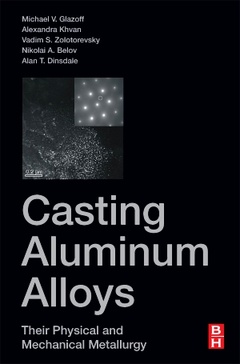Description
Casting Aluminum Alloys (2nd Ed.)
Their Physical and Mechanical Metallurgy
Authors: Glazoff Michael V, Khvan Alexandra, Zolotorevsky Vadim S, Belov Nikolai A, Dinsdale Alan
Language: English
Subjects for Casting Aluminum Alloys:
253.24 €
In Print (Delivery period: 14 days).
Add to cart562 p. · 15x22.8 cm · Hardback
Description
/li>Contents
/li>Readership
/li>Biography
/li>Comment
/li>
Casting Aluminum Alloys, Second Edition, the follow up to the fall 2007 work on the structure, properties, thermal resistance, corrosion and fatigue of aluminum alloys in industrial manufacturing, discusses findings from the past decade, including sections on new casting alloys, novel casting technologies, and new methods of alloys design. The book also includes other hot topics, such as the implementation of computational technologies for the calculation of phase equilibria and thermodynamic properties of alloys, the development of software for calculation of diffusion processes in aluminum alloys, computational modeling of solidification microstructure and texture evolution of multi-component aluminum materials.
In addition to changes in computational predictive abilities, there is a review of novel casting aluminum alloy compositions and properties, as well as descriptions of new casting technologies and updates to coverage on the mechanical properties of aluminum casting alloys.
1. Phase Diagrams and Thermodynamic Properties of Al-Bearing Alloys2. Non-Equilibrium Solidifications of Casting Aluminum Alloys3. Structure of Casting Aluminum Alloys4. Structure of Casting Aluminum Alloys after Heat Treatment(s)5. Industrial and Perspective Casting Alloys
This would be a valuable title for practicing engineers – developers of novel casting alloys, graduate students and seniors specializing in light metallic alloys it will also be a valuable resource for specialists in the general field of phase equilibria and thermodynamic properties of materials, computational materials science and applied physics; broad inter-disciplinary audience, from senior undergraduate level to graduate students to post-docs to scientists
Her areas of interest include the study of alloys and ceramics development and characterization, phase diagrams and thermodynamics. She is a member of the Materials Science International Team MSIT (Global); Chairman of the Materials Science International Team Russia; Member of the Materials Science and Technology editorial board (MST, IOM3); and was a member of the international Scientific Committee of the Calphad XLII conference 2013.
Vadim S Zolotorevsky is currently Professor of Materials Science and Light Alloys at Moscow Institute of Steel and Alloys, Russia. His areas of expertise include Physical metallurgy of Aluminium alloys, including nonequilibrium solidification, structure formation during solidification and its evolution during heat treating and plastic deformation, development of new Al-alloys.
He has published 8 books, over 200 papers in scientific journals, and has been involved with over 50 patents and inventions.
Nikolay A. Belov is currently the Chief Scientist and Professor of Materials Science and Light Alloys at National University of Science and Technology MISiS (former name “Moscow Institute of Steel and Alloys), Russia. His areas of expertise include Physical Metallurgy of Aluminum alloys, including development of new Al-alloys (both casting and wrought), analysis of multicomponent phase diagrams, structure formation during solidification and its evolution during heat treating and plastic deformation. He has published 17 books, over 300 papers in scientific journals and conference proceedings, and has been involved with over 50 patents and inventions.
Alan Dinsdale,Ph.D. is Professor of Materials Thermodynamics at Brunel
- Presents a discussion of thermodynamic calculations used for assessing non-equilibrium solidifications of casting aluminum alloys
- Expands coverage of mathematical models for alloy mechanical properties, helping facilitate the selection of the best prospective candidate for new alloy development
- Contains a new section that describes the self-consistent evaluation of phase equilibria and thermodynamic properties of aluminum alloys




